Did you hit that deep mud hole that was just TOO DEEP and now you majorly regret sending your machine through it. I understand because I’ve been there, done that. It happens all the time and I am here to help.
What to do if your ATV or UTV goes underwater? If you have water in your air box and you are certain there is water in your engine, do NOT try to crank the engine. Get someone to pull you back. The first thing you should do is clean the air box and air filter of any mud that entered. The next step is to remove your spark plugs and turn over the engine to shoot out any water that is on top of the pistons. Spray some WD-40 in the spark plug holes to dissipate any water that may remain and then put the spark plugs back. If your ATV is belt driven, you will need to remove the belt case and let that dry out as well. The next thing to do is flush your engine and differentials to remove any water within.
After this is done, make sure your air filter is dry and your ATV should be back to normal and ready to ride again.
If your ATV or UTV was completely underwater for an extended period of time, then you will want to flush your engine and differentials. Flushing your engine and other components is critical which is why I explain below.
When getting water inside the engine of your expensive atv or utv, it is crucial you flush the engine properly of any water that may be inside. Water can hydrolock your engine meaning that you will need a new engine. So here are the 10 steps to flushing your ATV engine.

Supplies Needed:
Supplies Needed:
Flushing your ATV differentials is a much easier process than flushing your engine. I actually recommend changing your differential fluids every 4-5 rides. If you do not drive through deep water and mud each ride then you can extend that frequency. The seals that keep your differential fluid inside are only designed to keep that thick oil inside, NOT to prevent water from coming in. Water WILL find its way inside your differentials especially driving through extremely deep water.
The seals that keep your differential fluid inside are only designed to keep that thick oil inside, NOT to prevent water from coming in. Water WILL find its way inside your differentials especially driving through extremely deep water.
There is no rocket science behind this, all that is needed is a wet towel to wipe down the inside of your air filter box. Spray out your air filter with a water hose and/or air filter cleaner and then hang it up to dry. After it drys, spray it with some air filter oil to help collect dirt, dust, etc. You may want to wear some gloves when spraying air filter oil because it tends to be sticky and can get messy real quick.
If you tried to crank your machine underwater or it sucked in water through your intake, you most likely have water sitting on top of your piston. Luckily, it's quit easy to remove. Take out your spark plug and turn over the engine. As the engine is turning over (it will not start with the spark plug out), you will see water burst from the spark plug hole. The piston is going up and down and will push the water out the top. Next, you want to spray some WD-40 into the spark plug hole which will dissipate any water on top of the piston and prevent the water from creating any rust inside your engine.
As the engine is turning over (it will not start with the spark plug out), you will see water burst from the spark plug hole. The piston is going up and down and will push the water out the top. Next, you want to spray some WD-40 into the spark plug hole which will dissipate any water on top of the piston and prevent the water from creating any rust inside your engine.
Scenario #1
If your exhaust goes under the water and your air intake is above the water then keep the engine running to prevent water from going inside the exhaust. If your engine cuts off at this time, do not try to crank it.
Solution: Get someone to pull you out and make sure there is no water in the air box. If no water, then try to tilt the ATV in the air to drain the water from the exhaust and then crank the engine to shoot out the excess water. If you cannot tilt the machine, you need to remove spark plug and then turn over the engine to get the water out of the exhaust.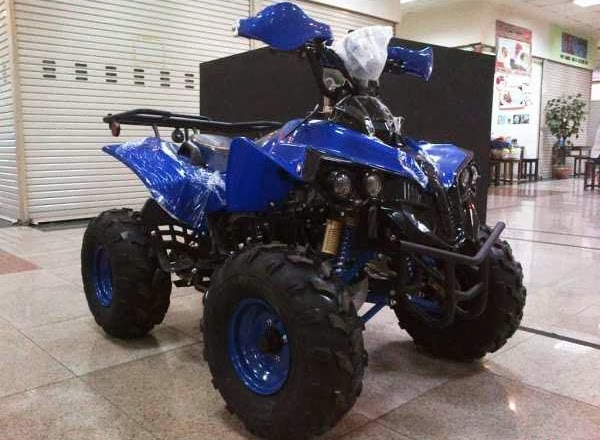.bmp) If you get water in your air box while your engine is running, you need to follow my instructions for flushing an engine.
If you get water in your air box while your engine is running, you need to follow my instructions for flushing an engine.
Scenario #2
If your exhaust is under the water and you know your air intake is about to go under then immediately shut your machine off before the intake goes under the water. This will prevent your intake from sucking water inside of your engine.
Solution: Drain your air box and exhaust (solution #1). The machine may need to be properly flushed depending on depth of water and length of time under.
Scenario #3
Your exhaust and intake are under the water while your engine is running and then the water chokes out the engine.
Solution #3: You need to be pulled back and have your ATV or UTV flushed out properly.
Ensuring that the coolant is in good shape is crucial in keeping your ATV engine from overheating. Sometimes, a regular coolant change is not enough; you need to perform what is known as a coolant flush.
Sometimes, a regular coolant change is not enough; you need to perform what is known as a coolant flush.
This post aims to provide the information you need about flushing the cooling system on an ATV, what it is, how to know when your ATV needs one, and a step-by-step guide on how to do a coolant flush.
Engine coolant systems vary in design, but the main principles remain the same. A basic ATV cooling system consists of a few key components:
The coolant’s primary task is to transfer heat away from the engine to the radiator. The coolant heats up while inside the engine and cools down when passing down through the radiator.
After cooling down, the coolant is sent back into the engine, and the cycle repeats itself. A pump ensures a continuous coolant stream from the engine to the radiator and back.
A pump ensures a continuous coolant stream from the engine to the radiator and back.
Coolant consists of distilled water, chemicals such as glycol or ethylene, and various additives. The chemicals do not carry heat effectively, so we dilute them with water. But why do we use coolant and not plain water?
Anti-corrosive. Using plain water as a coolant would cause internal corrosion in the radiator and engine, reducing the cooling capacity over time. Coolant contains anti-corrosive additives.
Increasing the boiling point. Coolant contains chemicals that raise the boiling point, allowing the cooling system to function at higher temperatures without boiling and overheating.
Decreases the freezing point. The chemicals in the coolant ensure that the fluid stays liquid at sub-zero temperatures.
Prevents deposits and foaming. Additives in the coolant avoid deposits of limestone and others that would reduce the cooling system’s efficiency. They also contain the liquid from foaming, which would reduce their efficiency.
They also contain the liquid from foaming, which would reduce their efficiency.
Coolant does not last forever. Over time, the coolant breaks down, becomes less effective, and eventually turns acidic, potentially causing damage to the engine and radiator.
That is why regular coolant changes are required as a part of a proper ATV maintenance schedule.
Some manufacturers, like Yamaha, recommend replacing the coolant every two years, while others, such as Polaris and Can-Am, operate with five-year coolant replacement intervals.
A typical maintenance checklist for the cooling system on an ATV includes the following:
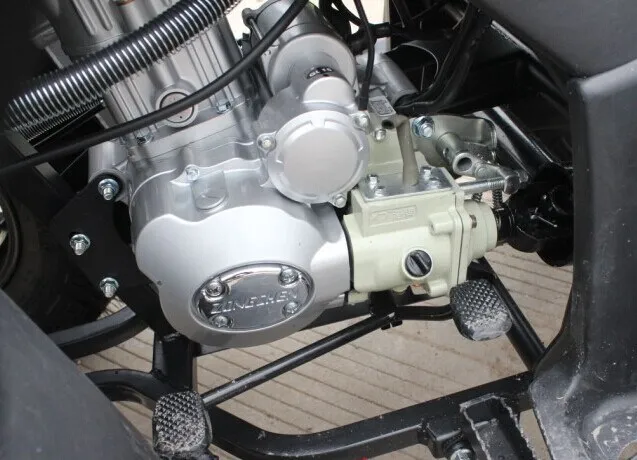
Flushing the cooling system, however, is usually not a part of your regular maintenance routine.
A coolant flush is like a service to the cooling system’s internals. After draining the coolant, a mixture of flushing medium and water is washed through the entire system to clean out rust, dirt, sludge, and any remaining old coolant.
Note that a coolant flush is slightly more comprehensive than a regular coolant change, as it adds a few more steps to the process. The flushing procedure happens after draining out the old and used coolant but before adding new.
Please refer to the How-to-guide below for details on how to perform a coolant flush on your ATV.
As long as you keep up regular coolant changes and only use the correct type of coolant, you may never need to flush the cooling system on your ATV.
However, there are several situations where a proper coolant flush is beneficial or even necessary.
Coolant is one of those things that is often neglected. Before you know it, a coolant change is long overdue.
Over time, the corrosion inhibitors in the engine coolant will break down, increasing the risk of engine or radiator internal corrosion.
When a coolant change is long overdue, the breakdown process may have gone too far, and you are better off performing a complete flush to ensure you only use fresh coolant.
The typical water-to-coolant ratio is 50/50 or 40/60. The mix becomes overly diluted if there is too much water relative to the coolant. This reduces the strength of the coolant, meaning its freezing point is too high. Adding too much coolant to water has the same effect.
The Minimum recommended coolant strength is typical -30ºC (-22ºF). Check the coolant’s strength (specific gravity) using an antifreeze tester (coolant hydrometer).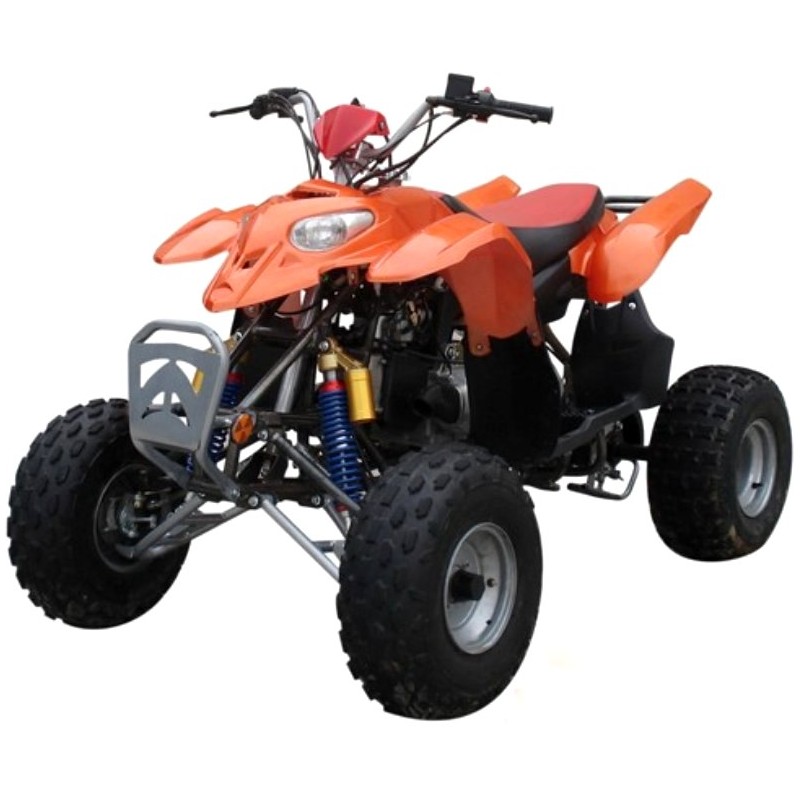
However, the test will not tell you the cause when the coolant does not carry the required strength. If you’re confident that the coolant is healthy but the mix is off, you could adjust by adding more coolant or water.
Otherwise, it’s better to do a complete flush and start with a new coolant. Choosing a pre-diluted mix helps eliminate any risk of messing up the mixing ratio.
As a bonus, when testing the coolant strength, you get to see if the coolant shows any discoloration or signs of contamination.
New coolant to the left, old coolant to the right.Fresh coolant should have a transparent, bright-colored appearance. When it’s turned brown and cloudy, you know the coolant breakdown and corrosion have gone too far.
In that case, you should always perform a complete coolant flush to eliminate all the old and degraded coolant.
Coolants come in various colors, from pink, red, orange, yellow, and blue to green. You used to be able to determine the type of coolant and what chemicals it was composed of by its color.
You used to be able to determine the type of coolant and what chemicals it was composed of by its color.
Nowadays, there is no way of knowing for sure. While some manufacturers apply traditional color coding, there is no guarantee the ingredients will go along.
Different coolant types do not mix well and may cause harm to your engine. If you bought your ATV used and don’t know for sure what coolant is on the ATV, you should flush all the old coolant to eliminate the risk of mixing two different types.
Flushing the coolant can help restore proper cooling in an ATV that suffers from overheating issues.
If your ATV is boiling or the temp light goes off, a coolant flush should be one of the first things to try.
A coolant flush may or may not solve the problem on your bike, but it’s a relatively cheap thing to try before looking into more serious causes.
Even if there are no evident signs indicating a coolant flush is in place, you might choose to do one as a preventative measure.
Debris may have started to build up even if the cooling system performs as expected.
A coolant flush to keep the system clean and clear of unwanted debris is a relatively affordable service that helps reduce the risk of engine damage and other more costly issues down the line.
Some manufacturer service manuals ask you to see a dealer do a coolant flush. However, the procedure is relatively straightforward and is something most people can do at home.
This step-by-step guide explains, in general terms, the whole process of an ATV cooling system flush. From draining out the old coolant, flushing the cooling system, filling the new coolant, and bleeding out the air.
None of the various ATV service manuals operate with precisely the same procedures, but the main principles are much the same.
A basic coolant change includes the following steps:

When performing a coolant flush, you add a few more steps, but the basic procedures for draining, filling, and bleeding remains the same.
Caution! Escaping steam or hot water can cause severe burns. Never remove the pressure cap (radiator cap) or the cap on a pressurized reservoir tank while the engine is warm or hot. Coolant draining should be performed when the engine is cold.
Notice: Before you begin, ensure you’re not voiding any remaining warranties and understand the potential hazards.
This will ensure the coolant drains entirely and that the levels are correct when it’s time to fill the new coolant.
When doing a coolant flush, you’ll get the best results if you start with a completely drained cooling system. The steps involved vary depending on the ATV’s design. The key is to get as much of the used coolant out of the system as possible.
This procedure also applies when draining out the flushing medium and water according to the “Flushing procedure. ”
”
Removing the radiator cap will make draining easier by allowing air into the system as the fluid drains out.
The radiator cap is on top of the radiator, usually located in front of your ATV. You may need to remove a few plastic covers or the front rack for access.
With a cold engine, turn the pressure cap anti-clockwise for about half a turn to open it. Remove it carefully to release any pressure in the cooling system.
Prepare a suitable container to collect the used coolant. The chemicals used in most coolants are poisonous and must be disposed of properly.
Most ATVs have a coolant drain bolt located on the lower part of the water pump assembly. Follow the radiator hose to find the pump on your bike.
The water pump on my Polaris is hidden behind a plastic side cover and does not have a drain bolt or bleed bolt.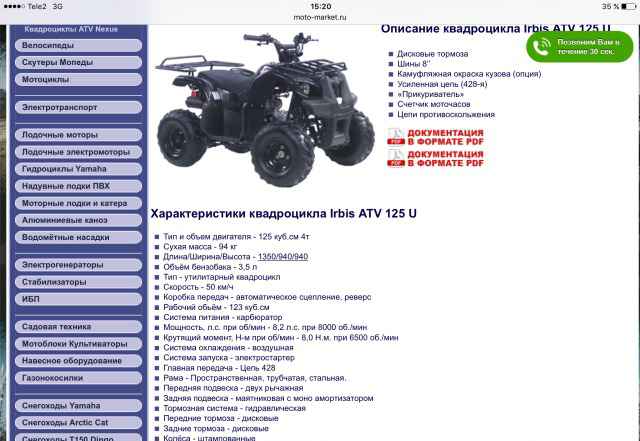
Notice: If the water pump is not accessible or it has no drain bolt, go to step 4 below.
To access the water pump and drain bolt, you may have to remove some components, such as plastic side covers, parts of the footwell, CVT duct, or exhaust shield.
Look for markings on the pump housing indicating the drain bolt’s location. Use the correct size socket to loosen the bolt without removing it.
The coolant comes out with a fair amount of pressure. Don’t remove the bolt entirely until you have positioned the container.
Release the drain bolt and copper washer from the water pump housing swiftly, trying not to make too much of a mess.
Allow the coolant to drain completely. Don’t re-install the drain bolt yet.
Notice: If you’ve successfully drained the coolant through the water pump as outlined in step 3 above, you can likely skip this step as the water pump is usually placed lower than the bottom of the radiator.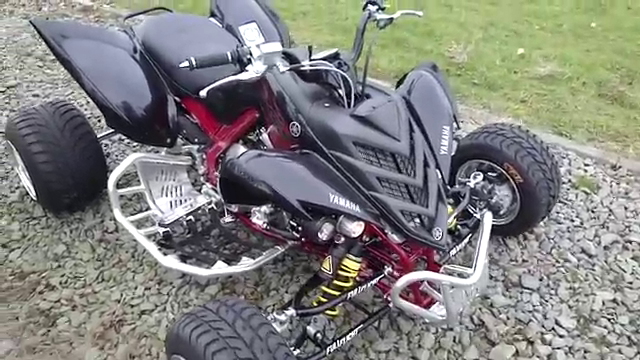 But there is no harm in performing this as well as a precaution.
But there is no harm in performing this as well as a precaution.
On some ATVs, the water pump is inconveniently placed, so it’s better to drain the coolant through the bottom of the radiator.
Some radiators have a dedicated drain bolt, while on others, you have to disconnect the bottom radiator hose.
Tip: Take note of the hose clamp position before loosening it. When re-installing the hose, the clamp should be in the same place for a good seal.
Disconnect the lower radiator hose by the radiator and allow the coolant to drain into a container for proper disposal.
At this point, most of the fluid should be drained, but there is likely some still left in the coolant overflow or pressure tank, usually located near the radiator at the top front end of the ATV.
Your ATV will either have a non-pressurized overflow tank (also known as a recovery tank) or a remote coolant pressure tank. You can tell them apart by what type of cap they have.
You can tell them apart by what type of cap they have.
An overflow tank is not under pressure and has a simple snap-on cap. A pressure tank is under pressure when the engine is hot and has a more robust tank design and a screw-on style cap.
When performing a coolant flush, the main difference is to remember not to open the pressure tank while the engine is hot, just like you should never open a radiator pressure cap while the engine is hot.
Disconnect the hose at the bottom of the tank to drain any remaining fluid in a container for proper disposal. Re-install the hose when all of the liquid is drained.
After all the fluid is drained, re-install the drain Bolt with a NEW sealing washer. Tighten to spec, typically 10Nm +/- 1Nm of torque.
Also, re-install the lower radiator hose to the radiator. Try to place the clamp in the same position as it was.
This procedure applies when filling the cooling system with a mix of water and flushing medium or new coolant after you’re done flushing.
Some ATVs have bleed screws on the water pump and thermostat housing to help bleed out trapped air.
Others apply a method for bleeding the air through the top of the radiator. The procedure for filling and bleeding varies slightly between the two.
If your ATV has bleed screws, your best option is to choose this method.
Ensure the radiator is cool to the touch, so there is no pressure built up in the cooling system before carefully removing the radiator pressure cap.
The air bleed bolt is located on the top of the water pump housing. Loosen the bolt without removing it. This will allow air to escape as you fill the system with fluid.

Tip: If the radiator does not have a cap, fill through the pressure tank. Use a funnel to avoid spills and fill fluid through the radiator’s neck.
Tip: While filling, squeeze the coolant lines to aid fluid flow and help purge the system of air. This is known as burping the cooling system.
Leave the pressure cap off for now.
On most ATVs, the coolant should be between the MIN and MAX lines when the fluid is cool. In that case, fill to the MAX level. Some ATVs use terms such as the lower lever and upper level or cold fill and warm fill.
Note that some ATVs should be only at the MIN-line when the fluid is cool. Please refer to your service manual to ensure you don’t overfill.
Some ATVs have a bleed bolt on the thermostat housing near the cylinder head.
Release this bolt without removing it to bleed out any air. When there is no more air but only fluid coming out of the bolt hole, tighten the bolt to spec.
Install any components you’ve removed to access the bleed bolts.
With the pressure cap off, start the engine and let it idle for 5-10 minutes to warm up. The radiator fan should cycle on and of at least two times. Leaving the cap off allows air to bleed out and will enable you to add more fluid if necessary.
Leaving the cap off allows air to bleed out and will enable you to add more fluid if necessary.
The level will drop as soon as you start the engine and once more as the thermostat opens, allowing fluid into the system.
With the engine still idling, top off the radiator with fluid when required.
When the engine has warmed up, snap/rev the throttle five times to release any remaining air.
Before shutting down the engine, install the pressure cap to avoid fluid spitting.
Notice: If you leave the engine running for too long after the thermostat opens, fluid may begin seeping through the top of the radiator. If this happens, it is time to stop the engine to prevent further spillage.
Tip: If you’re having difficulty bleeding the system of air, try elevating the front end of the ATV one to two feet while the engine idles. This helps trapped air to flow to the front of the ATV and out through the radiator filler neck. A safe and easy way to raise the front end is to drive the front wheels one or two steps into a set of outdoor stairs—lower the front of the ATV before topping it off with fluid to ensure correct levels.
Allow the engine to cool completely. You should be able to touch the radiator with your bare hands.
The filling procedure is now complete. Any air remaining in the system should continue to bleed through the recovery bottle. Keep an eye on the fluid level the next few times you ride.
Please refer to the “Draining procedure.”
Note that you do not need to install the drain bolt and bottom radiator hose for now (step 6).
With the drain bolt out, or the bottom radiator hose disconnected, pour a gallon or so of regular tap water into the radiator filler neck. Collect the fluid in a container for proper disposal.
Collect the fluid in a container for proper disposal.
Flushing solution, also known as radiator flush, can be bought at most automotive stores. Any brand will work; just ensure the fluid is compatible with aluminum radiators.
Notice: Make sure to follow the instructions provided with the flushing solutions, as they may be slightly different from this guide.
With the drain bolt out, or the bottom radiator hose disconnected, pour a mix of water solution and tap water into the radiator filler neck. Collect the fluid in a container for proper disposal.
Make sure you save enough flushing solution to fill the entire cooling system once more.
Please refer to step 6 in the “Draining procedure.”
Please refer to the “Filling and bleeding procedure.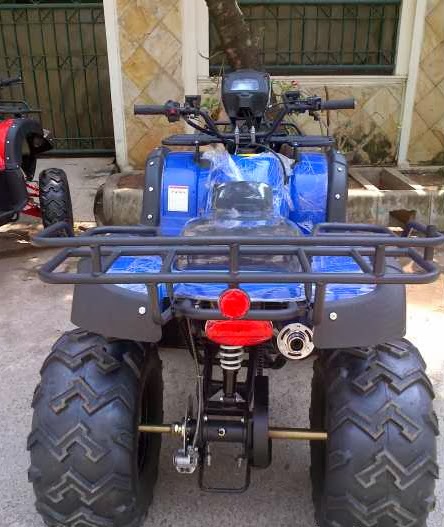.bmp) ” This includes running the ATV through a heat cycle.
” This includes running the ATV through a heat cycle.
Please refer to the “Draining procedure.”
Repeat steps 4 through 7, now only using regular tap water.
The flushing procedure is now done, and you are ready to fill fresh coolant into the system according to the “Filling and bleeding procedure.”
Maintenance is performed to keep the motor equipment in working condition, as well as to increase the uptime. Pre-identified and eliminated breakdowns and malfunctions allow you to prevent more serious malfunctions. An ATV, snowmobile or scooter that receives regular maintenance has a longer life span. The frequency of maintenance is prescribed in the service book of motorcycles.
In 4-stroke ATV and snowmobile engines, the engine oil is changed every 2000 km. (In a new engine, the first oil change must be done at a mileage of 300 km, then 1000 km, then every 3000 km.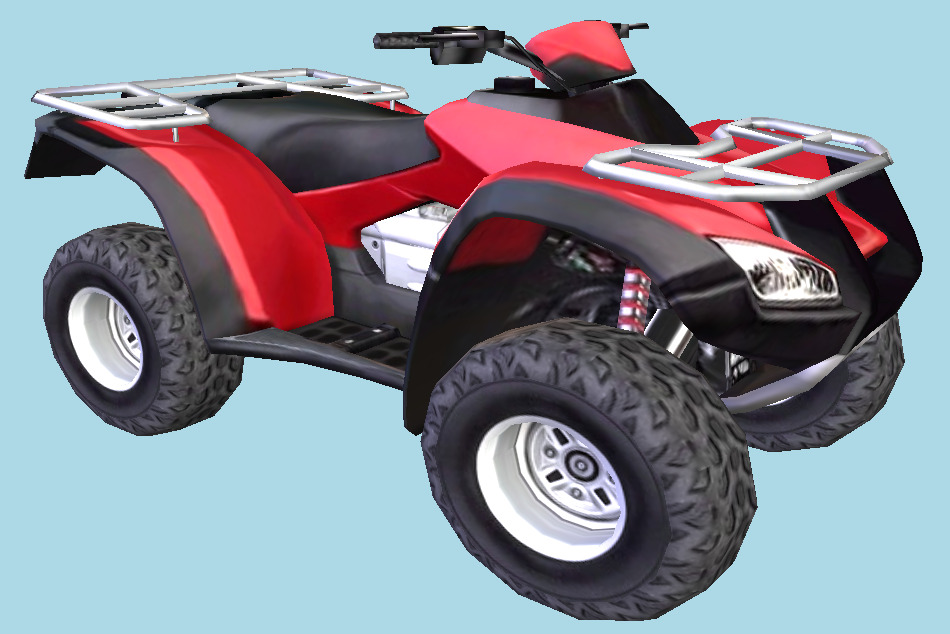 ) At each oil change in the engine, it is advisable to flush the engine with flushing oil before filling in new oil. This procedure makes it possible to completely wash and drain the exhaust from the engine of an ATV, UTV or snowmobile.
) At each oil change in the engine, it is advisable to flush the engine with flushing oil before filling in new oil. This procedure makes it possible to completely wash and drain the exhaust from the engine of an ATV, UTV or snowmobile.
When changing the engine oil in an ATV engine, be sure to change the oil filter. Before installing a new filter on an ATV engine, be sure to fill it with at least 1/2 full of oil. If there is none, as a rule, these are engines with a volume of 300 cc and below, then there is a mesh on the drain plug at the bottom of the engine crankcase, it must be washed in gasoline.
Transmission oil in gearboxes and gearboxes is recommended to be changed every 3000 km. Changing the gear oil in a new ATV or snowmobile is carried out after 300 kilometers.
The air filter maintenance interval when operating the motorcycle on dusty roads is 500 km. When performing maintenance, check the air filter. The filter element consisting of foam rubber must be washed in special. solution. Next, the foam element must be dried and treated with a special. air filter fluid.
The filter element consisting of foam rubber must be washed in special. solution. Next, the foam element must be dried and treated with a special. air filter fluid.
Spark plugs should be checked every 1-2 thousand km. run. After 5000 km. the spark plug needs to be replaced. When replacing a spark plug, be sure to set the spark gap as recommended by the engine manufacturer. For engines of various models of motor vehicles, the most suitable in all technical parameters, NGK and Denso brand spark plugs.
The fuel filter must be replaced at every service. On some models of ATVs, the fuel filter is located directly in the gas tank. In this case, a fuel cock with a filter element is installed.
Due to the fact that the ATV engine is often used in extremely difficult conditions, elevated temperatures and excessive loads cause conventional automotive oil to lose its properties, viscosity, etc. As a result, the pressure in the ATV engine lubrication system decreases, which can lead to “oil starvation” with all the ensuing consequences. The ATV engine must only be filled with Motul brand engine oil. This oil contains all the necessary additives to ensure the normal operation of all ATV engine components in all operating modes.
The ATV engine must only be filled with Motul brand engine oil. This oil contains all the necessary additives to ensure the normal operation of all ATV engine components in all operating modes.
Maintenance of UTVs and snowmobiles is not only about changing consumables such as filters and oils, it is just one of the service items. The maintenance procedure for motor vehicles is a series of works aimed at identifying and eliminating deficiencies affecting the safety and trouble-free operation of all units.
For maintenance of ATVs, snowmobiles and UTVs, our workshop stocks all the consumables and parts you need. In the absence of the required spare parts, we place an order and carry out repairs in a short time.
At MOTODOCTOR , you can carry out ATV, snowmobile or scooter maintenance according to the vehicle maintenance card. We install only original spare parts and use high quality technical fluids. You can sign up for ATV or snowmobile maintenance by calling +7(903)-752-17-36
Our ATV, UTV and snowmobile maintenance service is located at: Zelenograd, st. Andreevka, building 49How to flush a pit bike engine
Andreevka, building 49How to flush a pit bike engine
Whether you are a beginner or not, questions always remain. One of them is “What is an engine flush? How to use it? What is she doing? Is there any reason? How often to use it? etc.
Now let's try to explain and answer all these questions.
How to use it?
Easy to use. It is necessary to warm up the engine, as before a simple oil change. Next, add the required amount to the warmed oil. It is impossible to say exactly how much to fill in, because each manufacturer himself indicates the necessary proportions in the instructions. But usually it is no more than 25 ml per liter of oil.
How long should the motor run with oil flush?
Again, each manufacturer specifies its own time, but usually it is from 5 to 15 minutes, after which the engine must be turned off and all oil drained. You can just choose the average and keep the engine running for 10 minutes, no more.
Which flush should I choose?
Take what you like. The main thing is not quite “yauanhayan”: everything in this world is mixed from one barrel, and the difference is only in a slapped brand and added additives.
The main thing is not quite “yauanhayan”: everything in this world is mixed from one barrel, and the difference is only in a slapped brand and added additives.
We, for example, use either Motyulevskaya or Lukvimulevskaya.
IMPORTANT!!!
If you have filled in the flush, then in no case try to stand and fry at cut-offs and generally give gas! The engine should peacefully and calmly stand its 10 minutes at idle and nothing else.
Why can't you increase the speed, and what does flushing do?
The fact is that any engine works by means of friction, and friction is not only in the piston, but also in the gearbox, clutch and other components, as well as carbon deposits formed during the combustion of gasoline. Friction by and large is metal on metal, after which the smallest particles of metal are separated - this is called wear. And these very smallest particles are in suspension in the oil. Some part settles at the bottom of the crankcase, and some after each start rises again and again into the oil, and in addition to its lubricating properties, your oil already acquires the property of accelerating the wear of parts, because the metal suspension never bode well.
Flushing is done just to get most of this metal rubbish out of your crankcase, and, of course, to remove some of the carbon deposits and raise that settled part of the metal chips that settled to the bottom of the crankcase and remove it from the system.
If you give gas, then, of course, all the raised metal from all corners of the crankcase will spit you over all the nodes and parts, and if the box still bears this, then the piston rings may die.
But that's not all.
A logical question: why does not all this dirt go away with the oil when changing the oil?
The fact is that the oil is quite viscous and does not have an excessive fluidity. Therefore, oil cannot remove a very large part of the metal, because it itself is far from being 100% or even 90% removed from the crankcase, but remains in different technological cavities.
In addition, the oil has such a property as the ability to envelop the working part and form a stable oil film, in which some dirt also remains, well, there is one part, two, three - and so a lot of dirt will be collected from the entire motor. They achieve one or another property of the oil due to all the same additives.
They achieve one or another property of the oil due to all the same additives.
The wash is also a deactivator of additives embedded in the oil. The oil loses almost all of its properties, becomes more fluid, loses its lubricating properties and the ability to form a stable oil film.
Can you imagine what will happen to your piston group when you give gas, and instead of high-quality oil, the parts are paired with slurry, with a bunch of metal in suspension and excessively low lubricity? Yes Yes Yes! The motor will practically spit dry, your rings (this is at least) will say goodbye to you. Therefore, with flushing, it is necessary that the engine runs STRICTLY AT IDLE AND NO MORE THAN 10 MINUTES.
In fact, there is nothing wrong with flushing, if you approach things wisely, but is there any benefit?
Of course, there is a benefit. A lot of dirt is removed from the motor, including that which has settled to the bottom of the crankcase for months. By the way, this dirt can coke there for a very long time, and then a fairly large piece can suddenly rise up and, unfortunately, fly straight into the oil channel. The fact that the dirt is really removed and the additive works, you will understand by the color of the oil, this spectacle is beyond words. This is such a marsh or gray slurry, close in color to goose droppings.
By the way, this dirt can coke there for a very long time, and then a fairly large piece can suddenly rise up and, unfortunately, fly straight into the oil channel. The fact that the dirt is really removed and the additive works, you will understand by the color of the oil, this spectacle is beyond words. This is such a marsh or gray slurry, close in color to goose droppings.
Probably the last question - How often should I flush?
It is necessary to do this after each oil change, not only not recommended, but generally harmful. And in general, after every 10-15 hours, so many friction products do not form in the motor.
But after the break-in, it doesn't even hurt, because it is during the break-in that the so-called lapping process takes place, and this is accompanied by the abundant formation of metal chips.
And, of course, it doesn't hurt to clean the engine in the spring, before the new season, because if you haven't driven, then an aqueous suspension is formed in the oil one way or another, in other words, water.